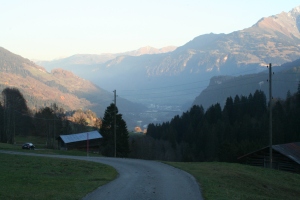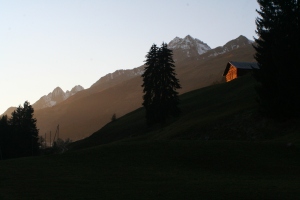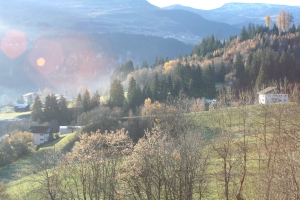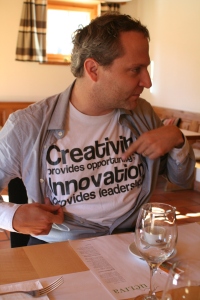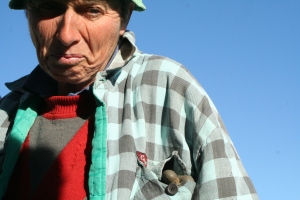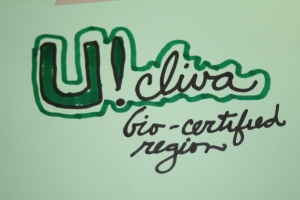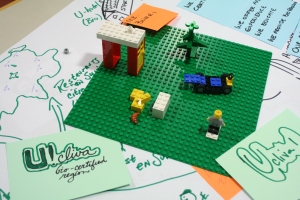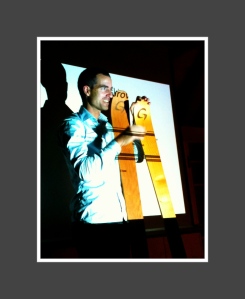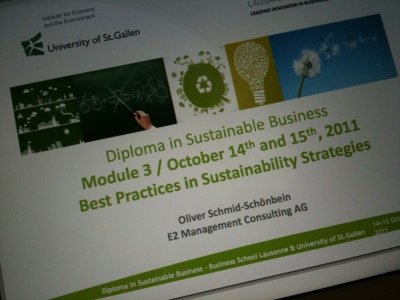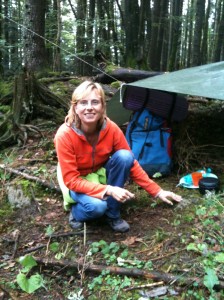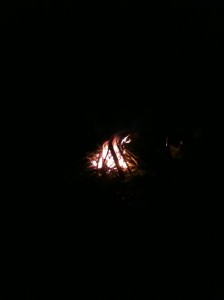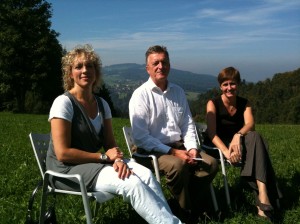I wonder if I have ever been to such a fantastic study location as the Ucliva hotel in Waltenzburg/Vuorz. The scenery is absolutely smashing.
Friends of course were jealous 😉
Module number 4 of the Sustainability in Business program brought us to the Swiss region of Chur.
In this module, we were to dive into the world of sustainability and design. More precisely, we were to learn about sustainability challenges as drivers for product and design innovation. This module’s professor was Prof. Bernard Rothbucher , who is head of research at Salzburg University of Applied Sciences and at the School of Design and Product Management.
Rotbucher’s approach to sustainability is the opposite of Olli’s (Oliver Schmid-Schönbein, our professor in Module 3) approach. Where Olli takes businesses as starting points, Bernard starts with consumers. It took me a while to figure that out. Things became clearer to me after a short interview with him.
“When consumers are happy with a product or service”, Bernard argues, “they’ll keep buying it. And this enables the businesses to prosper and keep on developing in a sustainable way.” His design thinking is, in fact, quite close to marketing. Bernard continues: “design starts with human beings, with the user. When you understand the user you can influence him positively. And that actually works toward sustainability.”
We talked about sustainability as the innovation driver for design management. In Bernard’s vision, design is much more than the actual shaping/designing of a product. To him, design expands from researching a product (who will need it and why?), to getting out the ideas (how will the consumer’s needs be met?) and tossing these ideas about with different people in the company. In order for design to bloom, management needs to have more creative skills and designers need to have more management skills. Bernhard feels design must be integrated in the whole developing process. This, in fact, is what I advise my clients when it comes to building up communication strategies.
Get to work
In the afternoon, we started working on a hands-on assignment: Imagine: the Ucliva Hotel wants to be the center of sustainability awareness in the Vuorz area. Design a product and a service necessary to create an authentic and universal experience for locals and visitors; young and old; for interested and currently non involved people. Quite a task! And, we ended by playing with lego. Let me explain how this worked.
As with all solutions we must come up with, researching and thinking it over is the key to finding bringing up these solutions. As I did in journalism, it’s about talking to everybody who is (slightly) involved in the issue, reading as much about it as possible, and ending by having a raw picture of what’s happening around the issue being researched. So, we took off to the village, talking to people about their village (if you understand the Romaensch language, but fortunately, one of my group members could talk Swiss German).
A peasant women (here she is, we called her Mrs. Janski) told us that winter time was not her favorite time in the village because it is very cold and the traffic in her village is horrific. Yes, traffic because of ski tourism, that is. In a local newspaper we found that the Ucliva Hotel needed CHF 250.000 to fund renovations. Also, we found that the Ucliva Hotel maintains high quality standards for suppliers, and for this reason, not all farmers from the village could deliver their food products to Ucliva.
These pieces of research combined, got us on the track of promoting Ucliva as a bio-certified area. An area where tourists are transported to the ski slopes by an electric bus, and thus ensuring Mrs Janski’s happiness. Tourists were supposed to pay extra taxes to sustain the bio area, but in return they got this absolutely clean and biological environment to stay in. This money would then get reinvested in the community, for instance to help local farmers and producers raise their standards and thus be able to supply to the Ucliva Hotel. And here’s the brand: U cliva, U cheese, U ski. And here’s the 3D version of our new brand. It’s about U!
It’s actually quite fun to break down a problem in such a way. One of my colleague participants was absolutely thrilled! In her company, or at least in her department, they’ve never looked at their customer needs in such a detailed way.
Ski sustainably
After this assignment, and after another fabulous dinner at Ucliva, Tobias Luthe came by to tell us more about his small scale production of sustainable wooden skis . Tobias, at 35-year old professor (?!) in sustainable sciences at Chur University, spends his spare time developing and producing these fabulous skis. He actually won a prestigious prize with them; his high-tech eco free ride skis won the first eco design award of the world’s major sporting goods industry fair ISPO in 2008.
Thomas told us about the bumpy road he has been on in the last few years. And even so, we all felt he had gold in his hands; eco-ski’s would certainly be mainstream sooner or later! But between dream and reality there is a gap; Thomas told us that in the last three years, he had to switch production sites three times. Because of this, and to stabilize Grown’s production, he hasn’t been able to spend the time he wanted on cranking up his production level or his marketing. When I look at his website though, it looks like a professional brand to me…
In fact, Thomas underwrote Bernard’s main message: if you have sustainable products, you need to talk about them. Media gives meaning to the product by telling stories. We have to tell better stories with better products. Thomas: “This ski, this product, is in fact a wooden beam. It’s not very sexy, unless you start talking in the name of this wooden beam, to convince customers about it.”
True words. Spread them.
